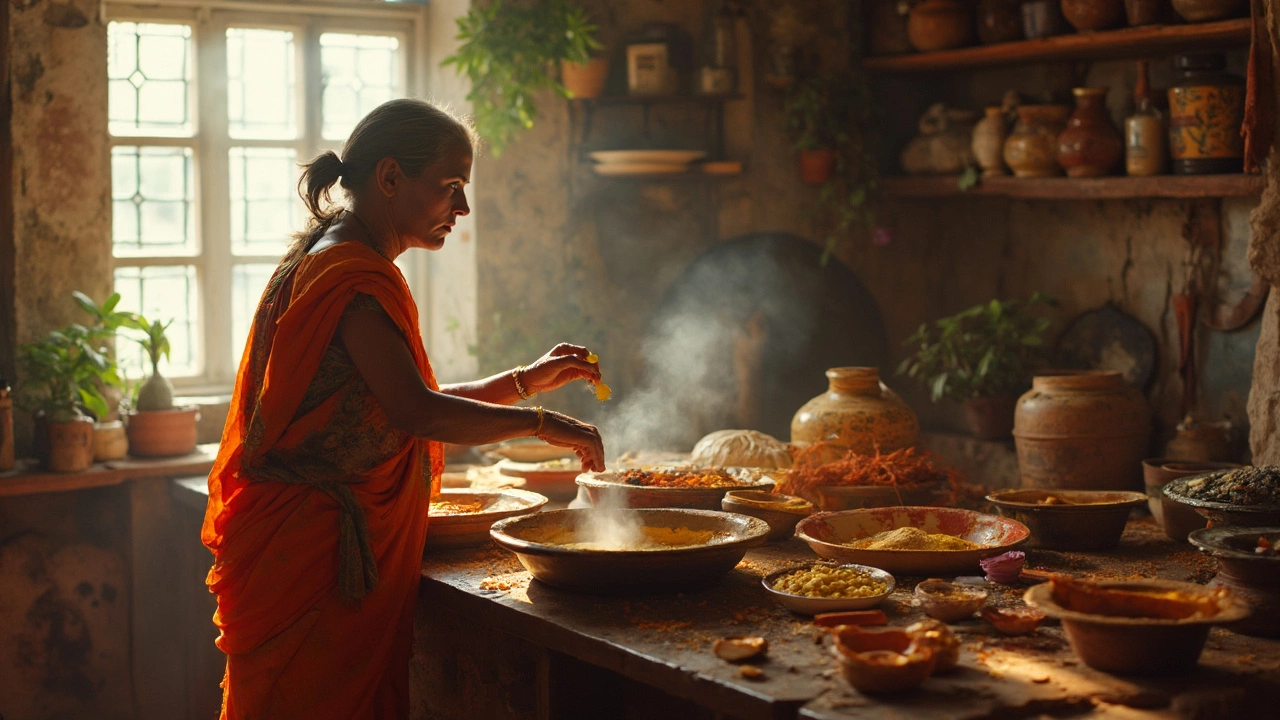Why is Baking Soda Added to Dosa Batter?
 Apr, 7 2025
Apr, 7 2025
Ever had a dosa that lacked that magical crispness or felt a bit too dense? You might want to check how you're prepping your batter. Baking soda—yep, the same stuff you use in baking cookies—might just be the secret ingredient you're missing out on.
For those unfamiliar, dosa is a thin, crispy delight from South India, made primarily from a fermented batter of rice and lentils. But here’s the thing—sometimes the natural fermentation doesn't give you the airy texture you crave. That's where baking soda steps in, making things light and fluffy.
Add baking soda just before cooking, and it will give your dosa that extra lift by reacting with the acids produced during fermentation. It's the same chemistry you'd see with a classic baking powder, but here it gives your dosa that satisfying crunchiness.
The Magic of Fermentation
Fermentation is at the heart of every good dosa batter. It's a natural biochemical process where good bacteria and yeast break down sugars over time. This isn't just some food science mumbo-jumbo—it really changes how your dosa turns out.
The primary purpose of fermentation in dosa batter is to create the gas bubbles that make your dosa crispy on the outside while keeping it soft inside. When rice and lentils ferment together, they create the perfect environment for these little bubbles. This is why your batter becomes all frothy and fluffy after sitting overnight.
Temperature and time are super important here. You want a warm spot, around 30°C (or 86°F for us Fahrenheit folks). If the room's too cold, it might take longer to ferment, and you could end up with a batter that's a little too dense.
Here's a neat tip: if you're in a colder climate, consider using your oven with just the light on—it can provide just enough warmth without cooking the batter. And don't skip on time. A rushed fermentation might leave you with disappointing results.
But all this magic varies because homemade dosas depend so much on the conditions they’re made in. That's why adding a little baking soda to your batter can be a game-changer, sort of a safety net to guarantee a perfect dosa even when conditions aren’t ideal.
A good indication of a well-fermented batter is its smell. A slightly sour aroma is normal and means you're on the right track. It enhances the dosa's flavor profile, making every bite a little tangy with just the right crisp.
Understanding fermentation gives you a handle on why our dosas turn out the way they do. It's like having a secret recipe up your sleeve, and knowing when to tweak it with something like baking soda lets you control the result every time.
| Fermentation Time | Ideal Temperature | Outcome |
|---|---|---|
| 8-12 hours | 30°C / 86°F | Light and crispy dosa |
| 12-16 hours | 25°C / 77°F | Firmer texture |
Role of Baking Soda
So, why add baking soda to your dosa batter? There's a little bit of science magic happening here, folks. Baking soda, or sodium bicarbonate, is a common household ingredient that's used to raise the pH level of the batter. This essentially speeds up the fermentation process and helps the batter double in volume, making your dosas crispy on the outside and fluffy on the inside.
Baking soda interacts with the natural acids produced by the fermentation of the rice and lentils. This reaction releases carbon dioxide bubbles, which get trapped in the batter. These bubbles are what help give the dosa its airy, light texture.
Here’s a cool fact: A little goes a long way. You don't need much—just a pinch for a medium-sized batch of batter. Add it right before cooking. If you add it too early, you might end up with an off taste or a batter that's too bubbly. Precision is key, folks.
Sometimes, if you’re in a hurry or if your batter didn’t ferment well overnight, baking soda is a quick fix. Just remember, it’s not a substitute for proper fermentation; rather, it’s like a booster shot for your batter.
A couple of tips: Don’t overdo it. Too much baking soda can make your dosa taste soapy. And always dissolve it in a bit of water before mixing it into the batter for even distribution.
| Ingredient | Amount |
|---|---|
| Rice | 2 cups |
| Urad Dal | 1 cup |
| Optional: Baking Soda | Pinch (1/4 tsp) |
So next time you're preparing dosa batter and find it's not as light as you'd like, grab some baking soda. But remember, a pinch is enough to get those delicious crispy edges we all love.

Perfecting the Batter
Alright, so you’re all about getting that perfect dosa, right? Let’s make sure you nail the batter every time. Starting with the basics, your ingredients should be top-notch. Use good quality rice and urad dal since they are the backbone of this dish. Measure them right—typically, a 3:1 ratio of rice to urad dal works wonders.
To get the fermentation process going, soak the rice and dal separately for about 4-6 hours. This softens them up just enough. Once you blend them with water to a smooth paste, the magic begins. Keep your batter a bit thicker during blending. You can adjust its consistency after fermenting. Store it in a warm spot; fermentation is all about temperature. Too cold, and you'll be left waiting forever!
- Blend your soaked ingredients to a smooth consistency.
- Mix them well and add salt, which aids fermentation.
- Leave it covered in a warm place—aim for around 78-82°F (25-28°C) if you can.
- Let it sit for at least 8-12 hours. You’ll know it’s ready when it’s bubbly on top and has increased in volume.
Right before cooking, this is when you sprinkle in a little baking soda. Just half a teaspoon can work wonders. Make sure to mix it in well without deflating the batter. This ensures each dosa is airy and crisp when fried.
Go ahead and experiment with your batter thickness by adding a tiny bit of water to see what works best for flipping and spreading. If you nail this, you'll get uniformly cooked dosas with a scrumptious crunch every time.
Baking soda's a small step, but it makes a massive difference. It interacts with the natural acids from the fermentation process, giving your dosa that extra rise, almost like a fluffy cloud with crispy edges.
Common Mistakes to Avoid
Making dosa batter seems straightforward, but a few stumbles can lead to disappointing results. Let's clear up the common slip-ups and make sure your dosas are nothing short of amazing!
First up, don't rush the fermentation. It's tempting to hurriedly cook before letting the batter properly ferment. Aim for a warm spot in your kitchen where it can sit undisturbed. This might take 8-12 hours, depending on your local climate. The batter should double in size and have a slightly sour aroma, a clear sign it’s ready to rock.
A common goof is adding too much baking soda. More isn't better here. Stick to about a quarter teaspoon for a medium-sized batch. Too much soda can alter the flavor and create an overly bubbly batter that's hard to cook evenly.
- Storing Batter Incorrectly: Don’t just shove leftover batter in the fridge uncovered or for too long. Make sure it’s in a tight-sealed container to preserve its vitality for a couple of days.
- Overloading the Pan: Pouring too much batter at once? This tends to lead to thick, uneven dosas. Aim for a thin layer by swirling the batter quickly in a circular motion.
- Temperature Control: Keeping the pan at the right heat is crucial. Test with a sprinkle of water; it should sizzle and evaporate immediately. Too hot, and the dosa may burn; too cool, and it sticks.
Once you avoid these pitfalls, you're well on your way to mastering the fine art of dosa making. It's all about those simple tweaks that bring that crispy, perfect finish!
